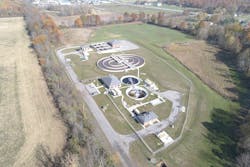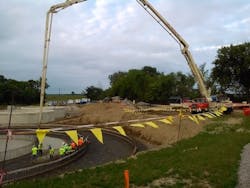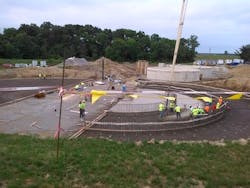Plant Profile: Huntertown Wastewater Treatment Plant
About the author:
Cristina Tuser is associate editor for Water & Wastes Digest. Tuser can be reached at [email protected].
Location: Huntertown, Indiana
Size: 1.5 mgd
Equipment: Simultaneous nitrification and denitrification, suspended growth activated sludge process, screens, grit removal, clarifiers, aerated anoxic reactors
Huntertown, Indiana, was originally called “The Opening” because it was a natural forest clearing. Today, it is the second fastest-growing community in the state, sporting a new $15 million, 1.5 million gallon per day wastewater treatment plant.
Previously, Huntertown had an agreement with an outside wastewater treatment provider in Fort Wayne. When this agreement expired, Huntertown made plans to build its own facility to address wastewater capacity issues. Huntertown began a five-year, $20 million plan, which allocated $5 million to restore collection capacity and $15 million to build an all-new plant.
After two years of construction, the plant opened in 2018. Due to costs and other restrictions that Fort Wayne implemented, the plan to create a plant in Huntertown was set into motion. Currently, the plant has two full time employees and another part time employee.
Anticipated Growth & Preparation
The treatment process at the plant involves discharges of a treated effluent that meets one of the lowest effluent limitations for concentrations of ammonia in the state of Indiana at 3 milligrams per liter (mg/L).
Huntertown collaborated with Engineering Resources Inc. to install Orbal systems that use single-stage nitrification and simultaneous nitrification and denitrification (SND) at the plant. The Orbal system features dedicated zones for specific treatment purposes, which operate in series during the treatment process.
The system’s suspended growth activated sludge process begins when screened and de-gritted wastewater is directed to the outer channel of the basin. After being mixed with RAS from the clarifiers, the combination passes through the system’s channels before passing on to the final clarifiers.
The outer channel is operated as an aerated anoxic reactor with dissolved oxygen levels near 0 mg/L. SND and phosphorus release occur in this zone. Oxidation and reduction potential (ORP) is used to monitor the condition of the outer channel.
The middle channel is a transition zone between the outer anoxic channel and the inner aerobic channel. Its condition may vary depending on the load coming into the plant. The inner channel is maintained in an aerobic state with dissolved oxygen levels at or above 2 mg/L. This supports the final nitrification required to complete treatment. Each channel is physically separated so the environment within each channel can be controlled to produce consistent treatment results.
Growing Pains
“A lot of our success revolves around our lab work and testing to make sure we are getting accurate results on what we’re bringing into the plant and how we are treating it, so we can make decisions on how to adjust our process accordingly,” said Darren Dafforn, Huntertown WWTP Superintendent. “Aside from that, we prioritize maintenance and planning ahead to accommodate future needs.”
According to Dafforn, accommodating future needs was built into the plant’s initial planning process. As the community is anticipating further growth, the plan built in a lot of capacity for the plant to plan for expected growth. Currently, the plant is 1.5 mgd and the expansion is designed to expand capacity to 3 mgd for average flow.
The growing pains of starting a new plant from scratch means getting a handle on a new learning curve. For Dafforn and his team, getting the hang of operations was a valuable experience in order to maximize efficiency.
“For the last year, we have been running chemical-free, in terms of phosphorus removal. We are 100% biological when it comes to nutrient removal,” Dafforn said. ‘We had some issues with phosphorus last year, but since then, we have been able to run all summer without any kind of chemical to aid the phosphorus removal. And I think that is an accomplishment.”


